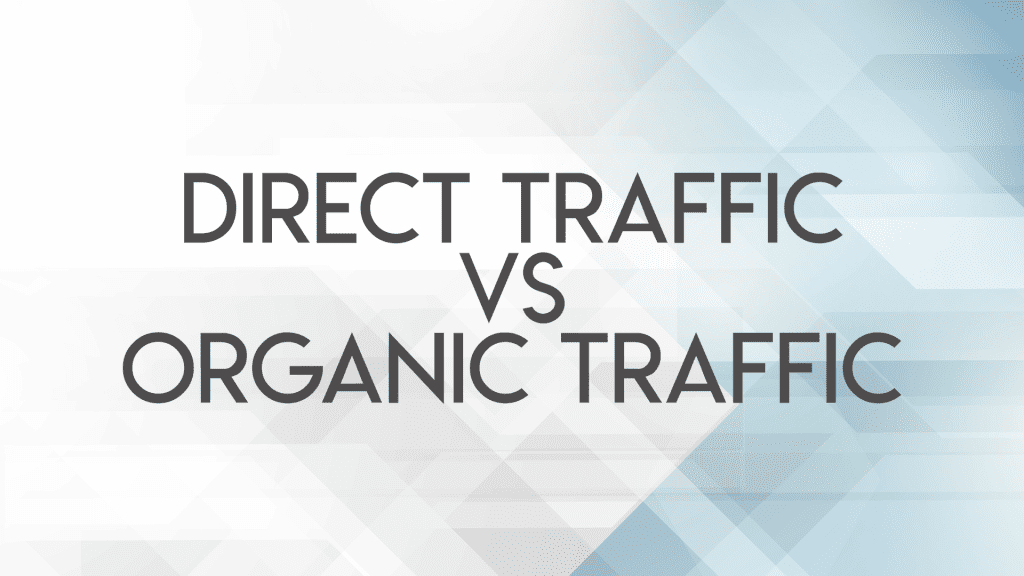Direct Traffic vs Organic Traffic: What You Need to Know
When it comes to the topic of direct traffic vs organic traffic, there’s a short answer and a long answer. Short answer: organic traffic is any traffic from visitors using search engines, while direct traffic comes from visitors arriving directly on your website without being referred by another site. This explanation is an oversimplification, which is why the rest of this blog post will be the long answer to this topic.
What Are Traffic Sources?
Before diving in much deeper on direct vs organic traffic, it helps to understand how all of your traffic sources are classified by analytics tools like Google Analytics. Most analytics platforms use algorithms based on the referring website to determine the source of traffic. Here’s a little breakdown:
- Direct Traffic: Any traffic that doesn’t come from a referring website, including traffic that comes from an unknown source.
- Organic Traffic: Any traffic that comes from search engine results – this traffic is earned, not paid for.
- Email Traffic: Traffic that comes from email marketing that has been properly tagged with email parameters.
- Paid Search Traffic: Traffic that results from paid search campaigns via Google Ads or another paid search platform.
- Referral Traffic: Traffic that comes from a user finding you through a site outside of major search engines and social media platforms. For example, someone visiting your website from a hyperlink on another blog.
- Social Traffic: Any traffic that comes from a social media platform, like Facebook, Twitter, LinkedIn, or Instagram.
- Other: Any traffic that doesn’t fit into the above categories, or has been tagged as “other”, will fall into this category.
Now that we’ve highlighted the different types of traffic sources, let’s take a closer look at two of the most important: direct traffic and organic traffic.
What is Direct Traffic?
Direct traffic consists of any traffic that doesn’t come from a referring URL. When a visitor follows a link from one website to another, the original site is considered the referrer. These websites can be search engines, social media platforms, blogs, or any websites that have links to other sites.
Direct traffic has traditionally been attributed to visitors manually entering the URL of a website or clicking on bookmarked links. Today, what qualifies as ‘direct traffic’ is a little more complex, and the amount of direct traffic websites are getting seems to be growing, especially for sites with growing organic traffic.
As we said, understanding direct traffic isn’t as simple as the definition above. This experiment done by Groupon in which they de-indexed their site for 6 hours found that nearly 60% of direct traffic is actually organic traffic.
How does that work?
Browsers don’t always report where exactly visitors arrived from when they land on a website. If your analytics tool can’t determine where traffic comes from, it’s just assumed that it’s direct traffic. Because that visitor isn’t coming from a referring site, your analytics won’t know where they came from, and will automatically place them into the direct traffic category.
We mentioned above that more websites are seeing direct traffic growth – let’s touch on that and what you can do about it.
Some of the most common causes of direct traffic are:
- Customers: If you have a customer portal on your site that customers can log into, this is categorized as direct traffic. Rather than completely filtering out this traffic, you can instead set up your analytics tool to view web analytics without this traffic.
- Internal Employees: It’s not uncommon for your employees to visit your site, and you most likely don’t have their IPs filtered from web analytics. To weed out this traffic, you can set your analytics to filter out all company IPs.
- Emails: Email clicks from Outlook or Thunderbird don’t typically pass on referring information. You should be able to easily identify whether an email spiked your direct traffic by analyzing traffic at the time a particular email was sent.
- Mobile Traffic: In the Groupon experiment mentioned earlier, Groupon determined that both the browser and device are important factors for analytics to track organic traffic. Mobile devices saw a 50% decrease in direct traffic when the site was de-indexed, whereas desktops saw a smaller impact from the test with only a 10-20% decrease. As the number of mobile users grows, we’re bound to see direct traffic rise as a result of increased organic traffic.
- Secure Sites (HTTPS) → Non-Secure Sites (HTTP): Most websites today are securely hosted since Google began emphasizing the importance of a secure site. If you haven’t secured your site yet, you have an HTTP site. Which means any traffic from a secure HTTPS site will not pass referral information to your site. This is just a part of the secure protocol and can be easily fixed. All you need is a third-party SSL certificate to secure your site.
- Mobile Apps & Desktop Software: As you can probably tell, there’s just no way to avoid direct traffic that isn’t actually direct. Programs such as news apps don’t pass on referral information, which means this type of traffic is deemed direct traffic. In order to capture and analyze this type of traffic, you’ll need to understand where your site links, including apps, are commonly used and where they show up digitally.
- Direct, Direct Traffic: When people enter your URL into their browser or visit your site via a bookmarked link – this is legitimate direct traffic. And it’s important to remember that some of your direct traffic is actually going to be direct because people know your brand. That’s great!
When looking at your overall website traffic, a typical amount of direct traffic is around 20%. But with things ever-changing, it’s getting more difficult to accurately identify true traffic sources, which means we’ll likely see this percentage rise.
Now, What is Organic Traffic?
Organic traffic is any traffic coming to your website from search engines – not including traffic influenced by paid ads. If you think about it, people trust search engines. How many times have you said or heard “just Google it”? Searching for things online is part of our everyday lives.
But even organic traffic, like direct traffic, has a few gray areas. Mainly because paid search, display, and offline campaigns do drive searches, which in turn increases organic traffic while those campaigns are running.
For the most part, organic traffic is driven by SEO. Think keywords – the better you rank for competitive keywords, the more organic traffic you’ll receive. Websites that have content optimized for search will see a steady climb in organic traffic and improved ranking in search results. This is an area digital marketers really like to hone in on – we’re always looking at keywords and high-ranking pages in order to identify new SEO opportunities.
Biggest Difference Between Direct & Organic Traffic?
The main difference between direct and organic traffic has to do with user intent. When you have an increase in organic traffic, you can credit that to developing your digital presence in a way that caters to search engines. You’re likely ranking highly for specific search terms, which is driving more organic traffic to your site. If you have a lot of direct traffic, you’re either killing your brand awareness game or dealing with some of the issues mentioned above.
For Example
Time for a new phone? Well, if you’re an extremely loyal Apple person and are ready to make a decision, you’re going to type in Apple.com in your browser and make a purchase. This is a very straightforward example of quality direct traffic.
Now if you’re someone who doesn’t care about name brands when it comes to electronics, you’ll probably type into a Google search something like “best smartphones on the market.” When you click on any of the top results (excluding ads), you’re classified as organic traffic for that website.
We’d Love To Talk
It’s important for marketers and website owners alike to understand the difference between direct traffic and organic traffic. Hopefully, this blog post helped explain some of the main differences between the two, and provide some context behind the issues we often see with direct traffic. As always, if you have any questions about analytics or would like to better understand your own website’s traffic sources, we’d love to talk!

